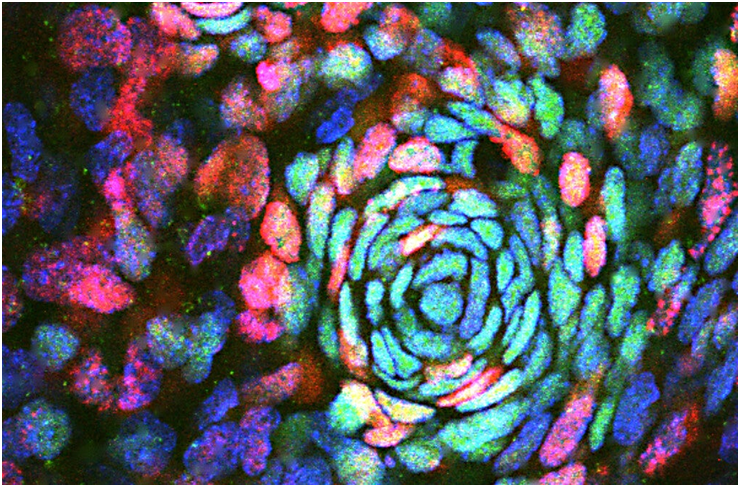A protein secreted by seemingly dormant cells in skin moles causes hair to grow again. That’s a big—and potentially useful—surprise.

MAKSIM PLIKUSloves talking about hair. The cell biologist from the University of California, Irvine rattles off obscure facts: Sloth hair has a green tinge thanks to symbiotic algae; African crested rats evolved hollow hairs, which they slather with a pasty bark-derived toxin to defend themselves; his last name comes from a Latvian word for “bald.” Growing up in Eastern Europe (he’s neither Latvian nor bald, despite his name), Plikus aspired to do biomedical research. He joined a lab that had him dissecting rat whiskers under a microscope. It was hard, and his hands would shake. But eventually he got the hang of it. “I started to appreciate just the beauty of the follicle,” he says.
Plikus interned at a hair transplant clinic before getting a PhD in pathology and starting his own lab that targets hormone-related hair loss. In pattern baldness, or androgenetic alopecia, stem cells in the follicle go dormant, meaning that they stop producing new hairs. Thick long hairs dwindle to smaller ones that shed more often and eventually vanish. “It's actually very exquisite, this micro-organ that most people don't really think is so complex,” he says.
Hair loss is underestimated, at least in terms of scientific research. It gets pegged as a cosmetic concern, not a medical one. “One does not die from hair loss. But our hair is part of our identity,” Plikus says. Losing hair takes a huge toll on mental health. Several studies have even reported that patients consider refusing chemotherapy over it.
Today, there are few treatment options. Two drugs (finasteride and minoxidil) can slow or stop loss, but show mixed results for regrowing hair—and results vanish when treatment stops. Another option is surgically transplanting follicles from the back of a person's head to the top. But this just shuffles existing hairs around. So Plikus pursued a new idea—and accidentally found himself exploring not just the mechanics of baldness, but of aging itself.
His journey began by investigating another cosmetic quirk: hairy moles, which form on the chest, arms, or elsewhere. Also called nevi, these dark spots grow long hairs, even though the skin around them is hairless. Over the past 10 years, Plikus’ team has delved into why hair grows here, hoping to pinpoint a protein that can do the same to the scalp. Now they’ve found it, he says: a protein called osteopontin.
In a battery of experiments described in June in Nature, the team reveals that osteopontin jumpstarts hair growth in mice. And in one test, the team achieved the same with human hair that had been grafted onto mice.
That had obvious implications for hair regrowth, but it also raised some intriguing questions about aging cells. The osteopontin in moles comes from cells that appear to be senescent—not dead, but no longer dividing. Senescence is protective because it stops cell mutations from proliferating into cancer. But it comes at a cost: Aging researchers have long assumed that these cells stick around to the detriment of the younger cells around them. When they stop replicating, they may contribute to age-related diseases by secreting harmful molecules and increasing inflammation and dysfunction.
Senescence plays a key role in nevi development: Mutated pigment-producing cells called melanocytes stop replicating as a failsafe to prevent themselves from turning into aggressive cancers. But something in their environment causes small hairs from the surrounding follicle to grow long and thick—to keep growing, even when other cells are not. “What you see in the mole is the exact opposite of what you see on the scalp of a person going bald,” Plikus says. “I became obsessed.”
It surprised Plikus to find that such a potent rejuvenator could emerge from senescent melanocytes—something that was supposed to be dormant, if not harmful, apparently creates healthy growth. “We’re now the first ever to show that there are instances where molecules secreted by such aged cells are beneficial for hair growth,” he says.
CELLS USE SIGNALING molecules, proteins, and hormones to communicate. A relatively small number of them account for thousands of functions throughout your body. For instance, the protein Wnt helps develop fat tissue and repair bones; the protein Shh (for Sonic the Hedgehog, because why not?) helps embryos develop fingers and a spinal cord. Both send cues to grow hair. But you can’t reawaken follicles by bombarding them with these proteins, because both can boost skin cancers. A signal that tells cells to grow isn’t limited to just healthy cells—dangerously mutated ones get the green light, too.
The objective for Plikus has been to find a signaling molecule that awakens follicles but not dormant cancer. He’s optimistic about osteopontin: Hair is generally a sign that a mole is not cancerous. And he points out that people can have hairy moles for decades, if not their whole lives, without danger.
Last year, Plikus’ team discovered that a protein called SCUBE3 was critical for regrowing fur in mice. SCUBE3 activated stem cells in mouse follicles, and Plikus envisions one day running trials to microneedle people’s scalps with SCUBE3 to encourage hair growth. However, he thinks that you can only learn so much from rodent hair. Hence: human mole hair. To find the right signaling molecule, his team carefully isolated melanocytes from nevus tissues to study individually. They sequenced their genetic material, then spent months analyzing the signaling molecules these cells produce, “and osteopontin came out of that,” he says.
In normal skin, osteopontin comes from dermal papilla, which sit at the base of hair follicles. In the new study, excessive osteopontin from melanocytes appeared to invade follicle stem cells, switching on hair growth.
To show that senescent melanocytes ooze out a molecule that reanimates follicles, the team engineered mice with nevi to not produce osteopontin. As expected, these moles didn’t become hairy. In a separate test, they confirmed that human hairy nevi overproduce osteopontin.
Their next step was to harness the effect: regrowing mouse fur. People grow hair continuously, but mice do it in bursts—so if you shave them, they’ll stay bald for a while. The team injected osteopontin into the skin of some of these newly-bald mice. Within 12 days, new hairs appeared on those that had received osteopontin.
Next, they got patients from a hair transplant clinic to donate follicles, then grafted those healthy hairs onto mice. Follicles normally undergo a sort of shock after a transplant, going dormant for a couple months. Plikus suspected that osteopontin could rouse the grafted follicles faster. Thirty days after grafting, some of these mice received osteopontin injections. Twenty days later, only those mice had sprouted human hair.
So far, the lab’s new paper has been well received—at least when it comes to the conclusions about growing hair. “It’s a really well-done and convincing paper,” says Valerie Horsley, a cell biologist at Yale University who was not involved in the work. Horsley likes that the team also pinpointed the follicle protein (CD44) that receives the signal from osteopontin. Without it, osteopontin has no effect. Tinkering with either could help regrow human hair, she thinks: “That would be cool. And we could inhibit it—stop hair growth in areas where we don’t want hair to grow.”
“It’s very exciting,” says Etienne Wang, a clinician-scientist specializing in hair at National Skin Centre Singapore. “We see hairy moles all the time. And no one ever really put two and two together.” He calls the results an important glimpse into what controls hair growth. “But I think we have to be quite cautious as well,” Wang says. It’s too early to tell whether this work will work as well on human scalps, or whether it could regrow dense hair. Most nevi only sprout a couple scraggly hairs. “It’s usually not a mole that’s got a full head of hair,” he says.
The takes on what this study might say about cell senescence are more mixed. “I was quite surprised,” says Claire Higgins, an expert in human hair biology at Imperial College London who was not involved in the work. “It challenges the dogma,” she adds, that dormant cells always damage their neighbors.
Higgins felt convinced by Plikus’ case, but others are more cautious. “Overall, I love the paper, which is something I don’t say very often,” says Horsley. But she points out that scientists don’t know much about how melanocytes affect their environment. Maybe they appear senescent but really aren’t. Or maybe the fact that they secrete osteopontin has nothing to do with being senescent. “That’s the link that they didn’t make,” she says.
Horsley is holding out for more compelling evidence. “There hasn’t been a lot of evidence for what senescence does in tissues,” she continues. “When anybody finds something, it’s a big deal.”
Plikus knows it’s a bold hypothesis. But recent animal research has offered a bit of support. He points to studies of zebrafish: If you amputate part of an adult’s fin, some of the remaining cells turn senescent. The fin naturally grows back, unless you remove the senescent cells. The same happens during mouse embryo development, and when researchers cut adult mouse livers and salamander limbs. All of these suggest that senescent cells can release proteins that help the body heal. For that reason, Plikus thinks it’s plausible that molecules from aged cells could help grow hair.
Plikus’ startup, Amplifica, began human clinical trials of a proprietary version of osteopontin in June. Participants will get it as a microneedle injection into the scalp. (He envisions it one day becoming a twice-a-year treatment, like Botox or a dental cleaning.) Amplifica is also continuing preclinical studies of SCUBE3.
It’s still not clear whether his lab has stumbled across a phenomenon common to all aging tissues, or whether nevi are simply unique. But Higgins thinks that figuring out how to kickstart hair growth is fascinating enough. “He’s shown how a thing we all know happens actually occurs,” she says. “It’s a testament to his foresight that he was able to take this observation and run with it.”







Post comments